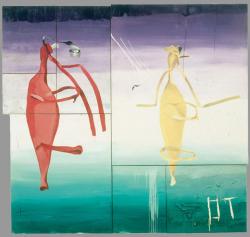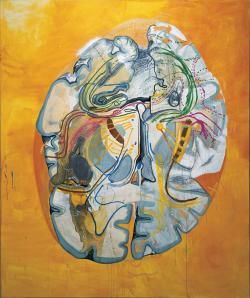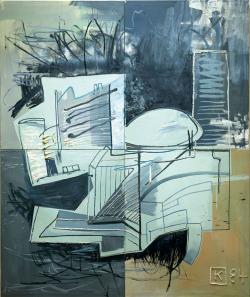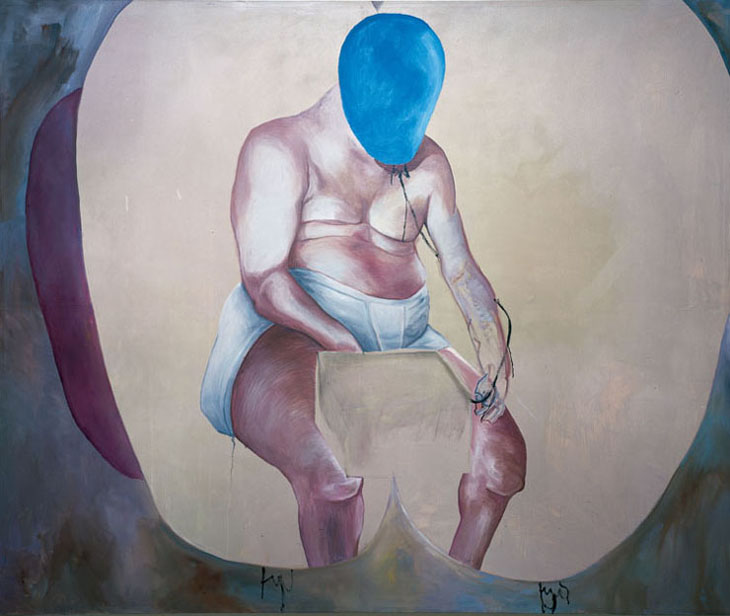

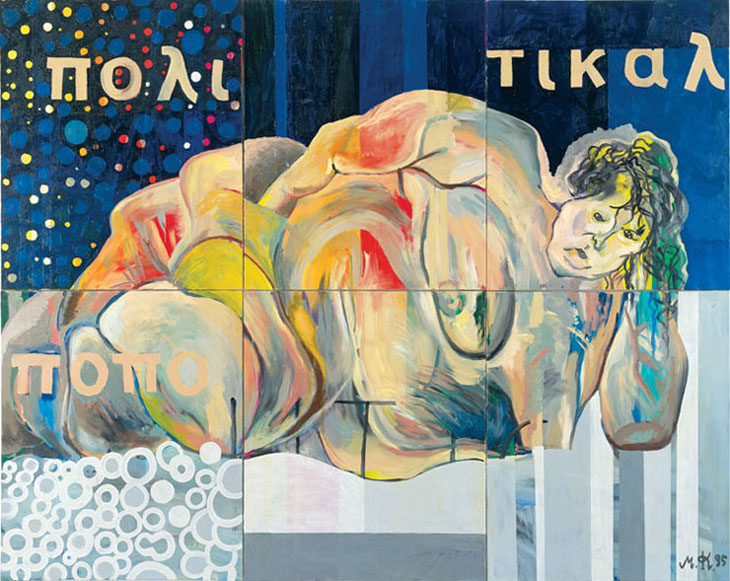

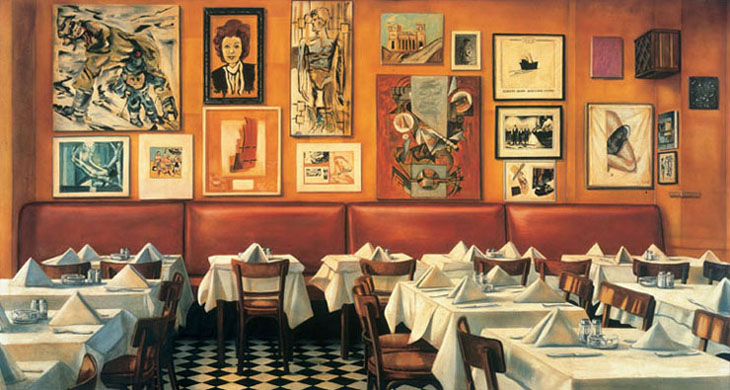


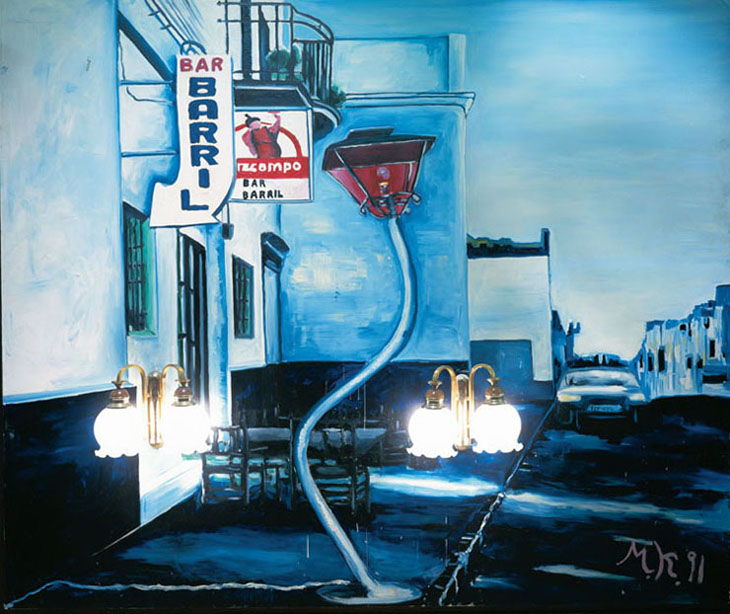

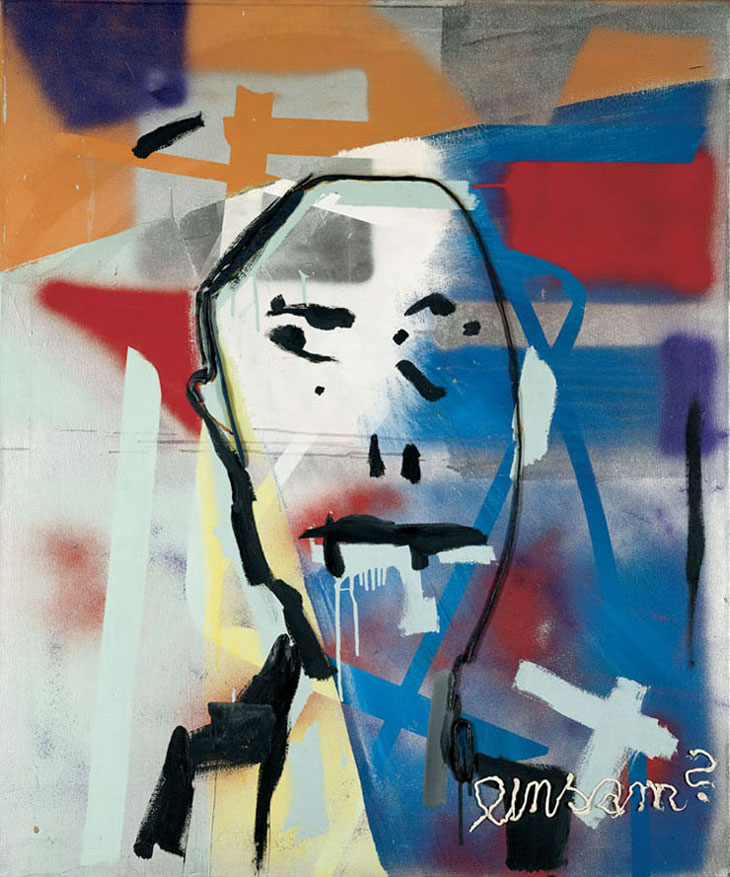
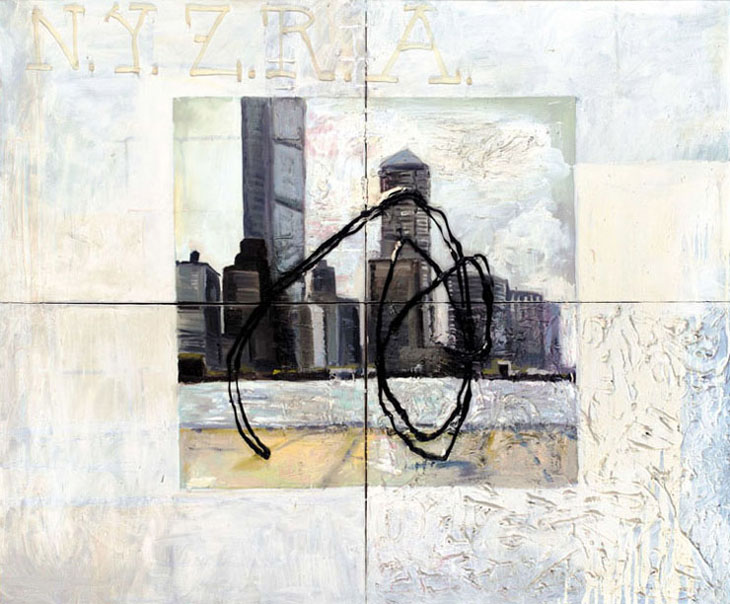
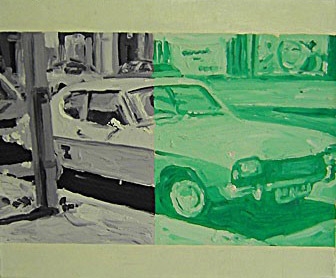
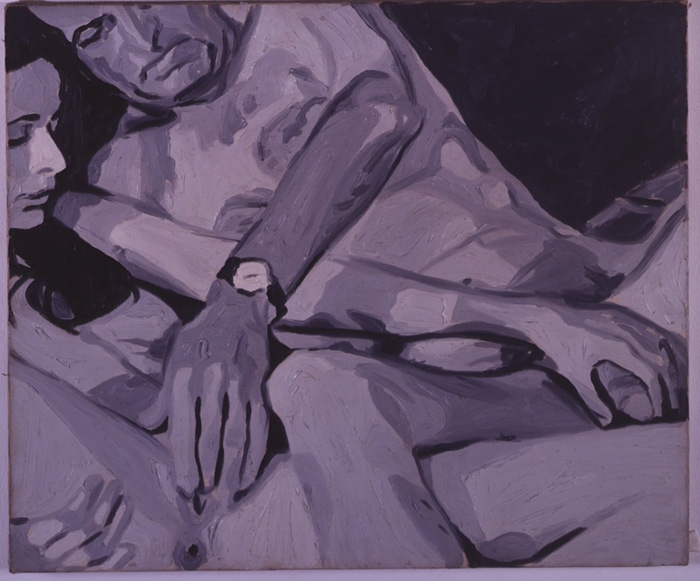
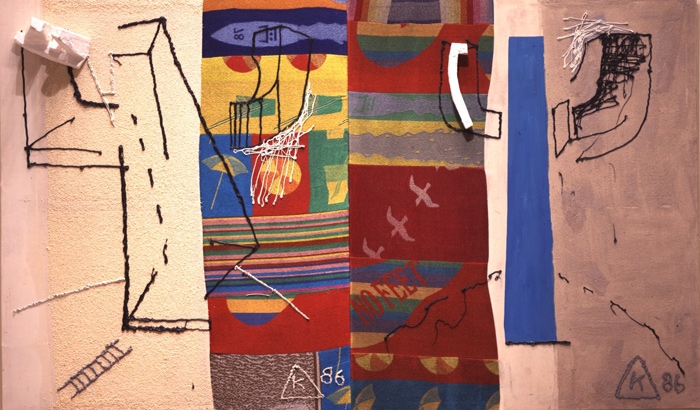
ARTIST:
Martin Kippenberger
In Martin Kippenberger’s remarkable series of self-portraits from 1988, he pictures himself with a touching lack of vanity. An exaggerated beer belly, folds of fat, a thick neck, and dejected posture present a melancholic, awkward and somewhat grumpy figure. He wears immense white underpants pulled up high on his hips – rather like a well-known photograph of Picasso.
Borrowing equally from graffiti and traditional avant garde painting O.T.’s strange floating figures are reminiscent of surrealist artists such as Joan Miro, while its impoverished style and construction keeps in line with Martin Kippenberger’s populist values.
By piecing together 7 canvases, Martin Kippenberger creates the illusion of grandeur - an image too enormous to be contained in just one. Untitled trades in high-art esteem for a certain comic brutality; it’s beautiful and stupid at the same time, a re-invention of abstract painting for a sophisticated and grown-up Hanna-Barbara generation. Every aspect of Martin Kippenberger’s practice was a self-contained act of decadence, designed to add to the myth of the artist as a whole. In I Am Too Political, Martin Kippenberger paints an image stripped of direct content: six canvases joined together as one form a billboard-like design, bolstering a grotesque nude. Kippenberger’s painting operates as an anti-advert for itself, poking fun at the tradition of painting and the way it’s been historically and ideologically subverted. Paul Schreber was a senior judge in Germany in the 1870s, whose mental breakdown was recorded in his autobiography Memoirs of a Nervous Illness. Like Jung and Freud, Martin Kippenberger was fascinated by Schreber’s record of life in a mental institution, and presents the viewer with an insight into Schreber’s brain. In Paris Bar, Martin Kippenberger writes his own importance in art history. Acting as curator, he installed the café’s art collection; then as shameless self-promoter, he painted the café interior. Reminiscent of eighteenth and nineteenth century paintings of salon interiors, Martin Kippenberger places himself on a par with the masters, drawing on early 20th century American art. Rooted in the daily life of the painter Ohne Titel (Lieber Maler, male mir…) is a work that demonstrates this consistent aspect of Kippenberger’s work more clearly than most. Shot from the back, the photograph on which the painting is based depicts two evidently close and almost tragi-comic figures heading on a bar crawl through the streets of Düsseldorf. The ordinariness of the scene and the fact that it is daylight with the streets still full of people underscores both the mundaneness and the gritty realism of the image. It is both an intimate and tender image of ordinariness, made epic and extraordinary by its magnification and translation into a slick photorealist oil painting.
Lieber Maler, male mir…(Dear Painter, paint for me…) is one of the earliest and most important series of Kippenberger’s works. It is a series of twelve paintings that Kippenberger commissioned to be made for him by the film poster painter known as ‘Mr Werner’. The delegation of the making of this series of paintings to another is not only a clear dig at the earnestness and supposed ‘authenticity’ of the very ‘painterly’ Neo-Expressionist art, then currently in vogue in Germany, but also a firm statement about Kippenberger’s sense of identity as an ‘art/business/life artist’. As such the Lieber Maler, male mir… series forms one of the few lynchpins through which much of the later diversity and eclecticism of Kippenberger’s oeuvre can begin to be understood. Sharp-witted self-irony was a large part of Martin Kippenberger’s strategy: borrowing from all aspects of culture ensured his own relevance within it. Kippenberger’s architecture paintings are a grandiose epitome of ego, and a megalomaniac approach to urban design. His buildings are the most enduring form of creation, with city planning the ultimate tribute of power and genius.
In U.N.Building, Martin Kippenberger renders a blueprint of complete dysfunctionality: chunky shapes of cubism gone wrong, engulfed in a forbearing scribbled black smoke. His fragmented canvas adds to the image’s instability, the bottom right section providing only the scantest hint of solid foundation, from which his topsy-turvy metropolis might aspire. Kellner Des… derives from a stereotype cartoon image of a bent street lamp. Without the figure of the drunk leaning against it, Martin Kippenberger’s deadpan Austrian street is completely empty of human life. To reconfirm the painterliness of the image and the dysfunctional nature of the lamp, he has placed two real wall lights either side of the painted street lamp, to bring a glow of comfort to an otherwise cold and deserted scene. Kellner Des… also once hung in the Paris Bar. Deep Little Throat reverberates with perverse seduction. Made from fetishist black rubber, it bares all the boiled-over passion of a randy night in the sack. Depicting two ‘pillows’ bouncing on a diving board, Martin Kippenberger takes a dumbed-down, humorous look at sex with its awkward subculture of taboo and embarrassment. A dashed-off slacker anthem to portraiture, Martin Kippenberger’s Mr Lonely manages to be sparky and buoyant, melancholy and pierced all at once, in a few seemingly casual brush strokes. Martin Kippenberger developed an elaborate concept of aesthetics where the trivial and the subcultural became as influential on his working practice as the masterpieces of art history. Often sparked off by the banality of life, by politics, media and advertising, for Kippenberger there was no subject which could not be turned into art.
In New York zum Russich Abbinden the romance of the New York skyline is dramatically broken by a fusion of compositional and painterly effects. Taking a subject as serious as the Cold War which had reached a critical moment in the mid-1980’s, the work consists of four quadrant canvases joined together within a single frame, placing a permanent ‘crosshair’ on the New York landscape. The hairline gaps between the canvases and the thick silicon under and over the painted surface add a dramatic sense of fragility and corruption to this universal symbol of Western capitalism and power.
By piecing together 7 canvases, Martin Kippenberger creates the illusion of grandeur - an image too enormous to be contained in just one. Untitled trades in high-art esteem for a certain comic brutality; it’s beautiful and stupid at the same time, a re-invention of abstract painting for a sophisticated and grown-up Hanna-Barbara generation. Every aspect of Martin Kippenberger’s practice was a self-contained act of decadence, designed to add to the myth of the artist as a whole. In I Am Too Political, Martin Kippenberger paints an image stripped of direct content: six canvases joined together as one form a billboard-like design, bolstering a grotesque nude. Kippenberger’s painting operates as an anti-advert for itself, poking fun at the tradition of painting and the way it’s been historically and ideologically subverted. Paul Schreber was a senior judge in Germany in the 1870s, whose mental breakdown was recorded in his autobiography Memoirs of a Nervous Illness. Like Jung and Freud, Martin Kippenberger was fascinated by Schreber’s record of life in a mental institution, and presents the viewer with an insight into Schreber’s brain. In Paris Bar, Martin Kippenberger writes his own importance in art history. Acting as curator, he installed the café’s art collection; then as shameless self-promoter, he painted the café interior. Reminiscent of eighteenth and nineteenth century paintings of salon interiors, Martin Kippenberger places himself on a par with the masters, drawing on early 20th century American art. Rooted in the daily life of the painter Ohne Titel (Lieber Maler, male mir…) is a work that demonstrates this consistent aspect of Kippenberger’s work more clearly than most. Shot from the back, the photograph on which the painting is based depicts two evidently close and almost tragi-comic figures heading on a bar crawl through the streets of Düsseldorf. The ordinariness of the scene and the fact that it is daylight with the streets still full of people underscores both the mundaneness and the gritty realism of the image. It is both an intimate and tender image of ordinariness, made epic and extraordinary by its magnification and translation into a slick photorealist oil painting.
Lieber Maler, male mir…(Dear Painter, paint for me…) is one of the earliest and most important series of Kippenberger’s works. It is a series of twelve paintings that Kippenberger commissioned to be made for him by the film poster painter known as ‘Mr Werner’. The delegation of the making of this series of paintings to another is not only a clear dig at the earnestness and supposed ‘authenticity’ of the very ‘painterly’ Neo-Expressionist art, then currently in vogue in Germany, but also a firm statement about Kippenberger’s sense of identity as an ‘art/business/life artist’. As such the Lieber Maler, male mir… series forms one of the few lynchpins through which much of the later diversity and eclecticism of Kippenberger’s oeuvre can begin to be understood. Sharp-witted self-irony was a large part of Martin Kippenberger’s strategy: borrowing from all aspects of culture ensured his own relevance within it. Kippenberger’s architecture paintings are a grandiose epitome of ego, and a megalomaniac approach to urban design. His buildings are the most enduring form of creation, with city planning the ultimate tribute of power and genius.
In U.N.Building, Martin Kippenberger renders a blueprint of complete dysfunctionality: chunky shapes of cubism gone wrong, engulfed in a forbearing scribbled black smoke. His fragmented canvas adds to the image’s instability, the bottom right section providing only the scantest hint of solid foundation, from which his topsy-turvy metropolis might aspire. Kellner Des… derives from a stereotype cartoon image of a bent street lamp. Without the figure of the drunk leaning against it, Martin Kippenberger’s deadpan Austrian street is completely empty of human life. To reconfirm the painterliness of the image and the dysfunctional nature of the lamp, he has placed two real wall lights either side of the painted street lamp, to bring a glow of comfort to an otherwise cold and deserted scene. Kellner Des… also once hung in the Paris Bar. Deep Little Throat reverberates with perverse seduction. Made from fetishist black rubber, it bares all the boiled-over passion of a randy night in the sack. Depicting two ‘pillows’ bouncing on a diving board, Martin Kippenberger takes a dumbed-down, humorous look at sex with its awkward subculture of taboo and embarrassment. A dashed-off slacker anthem to portraiture, Martin Kippenberger’s Mr Lonely manages to be sparky and buoyant, melancholy and pierced all at once, in a few seemingly casual brush strokes. Martin Kippenberger developed an elaborate concept of aesthetics where the trivial and the subcultural became as influential on his working practice as the masterpieces of art history. Often sparked off by the banality of life, by politics, media and advertising, for Kippenberger there was no subject which could not be turned into art.
In New York zum Russich Abbinden the romance of the New York skyline is dramatically broken by a fusion of compositional and painterly effects. Taking a subject as serious as the Cold War which had reached a critical moment in the mid-1980’s, the work consists of four quadrant canvases joined together within a single frame, placing a permanent ‘crosshair’ on the New York landscape. The hairline gaps between the canvases and the thick silicon under and over the painted surface add a dramatic sense of fragility and corruption to this universal symbol of Western capitalism and power.

